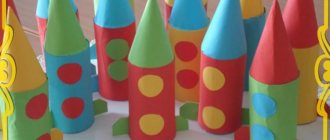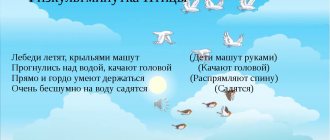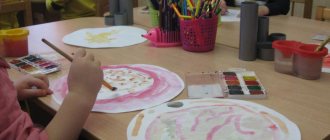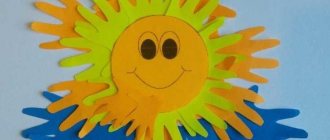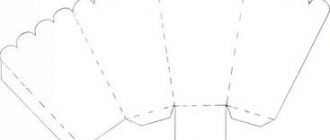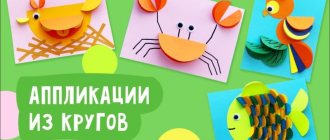Abstract of the educational activity “My city is St. Petersburg”.
Author: Grekhova Olga Vyacheslavovna
Educational institution: GBDOU Kindergarten No. 38, Pushkinsky district
Locality: St. Petersburg
Topic: Abstract of the educational activity “My city is St. Petersburg” in the middle group.
Library Section: Lesson Developments
Goals:
Expand children's knowledge about the city in which they live. Introduce the main attractions of the city of St. Petersburg. Develop social and communication skills, speech, artistic and aesthetic perception, physical activity, imagination, attention. Cultivate love for your hometown.
Materials and equipment:
Presentation of illustrations on the computer (Peter I, Peter and Paul Fortress, Nevsky Prospekt, Neva River, drawbridges, Palace Square, Winter Palace, Chizhik-Pyzhik monument). Envelope with tickets. Conductor's bag. Walnut shells, wooden sticks, colored paper for creating boats.
Modern educational technologies:
Research technology (travel on a map, travel along the “river of time”). Information and communication technologies. TRIZ technology.
Progress of the lesson:
Organizing time. Educator: Guys! Look what I found. What is this? That's right, an envelope. There is something written on it: “For children from the Zvezdochki group.” Shall we open the envelope and see what's inside? Here's the letter. This is what it says: “Dear children! My name is Chizhik-Pyzhik. I invite you to a tour of our city of St. Petersburg by bus. I have prepared a ticket for everyone. I am waiting!" Guys, this is great! And we will find out who Chizhik-Pyzhik is a little later.
Do you know what an excursion is? This is when people gather to visit famous places in the city. And I will be your tour guide, or guide, as I will tell you about the interesting places of our wonderful city.
I suggest that Alice give out tickets for the guys, but to do this, they must first be put in their purse. Who will Alice be for us? That's right, a conductor.
Physical education Poem "Bus".
Forward, forward the bus,
Spin your wheels!
Hurry, hurry, driver,
Start your engine!
Getting to know the city. Educator: Here we are. Our city, St. Petersburg, is one of the largest and most beautiful cities. Many years ago, among swamps and forests, Tsar Peter I (portrait of Peter I) began to build a new city on Hare Island. He named it St. Petersburg. The construction of the city began with the Peter and Paul Fortress (illustration).
Guys, do you know what a fortress is?
Peter I built several buildings on Hare Island and to protect them from enemies, cold wind, and water, he built a high and strong wall around it. And it turned out to be a fortress.
Let's move on, guys. And so our bus turned onto the main street of our city - Nevsky Prospekt (illustrations). What do we see? Beautiful old houses and a wide road. There are always a lot of people on Nevsky Prospect, including from other countries.
And so we drive further, and what do we see? The Neva River (illustrations). What kind of river is it? Deep, most likely cold. In winter, it becomes covered with a crust of ice and looks completely different than in summer. Our city is also called “City on the Neva”.
Do you see this unusual bridge that opened into two parts? There are several such bridges in our city. They are deployed at night so that large ships can sail along the river, which simply would not sail under an unopened bridge.
Let's spread our elbows to the sides, connect our middle fingers to each other and imagine that this is a bridge. And then night comes. A big, big ship is approaching, and we need to let it pass. We raise our palms up, bending them at the hand. This is the principle by which bridges are moved apart.
Artistic work. Educator: Guys, Chizhik-Pyzhik asked us to make boats to sail them along our Neva River. Let's sit down at the tables and fulfill our friend's request. (Children sit at the table and make boats from walnuts, wooden sticks and colored paper as sails).
Continue exploring the sights of the city. Educator: Having driven along Nevsky Prospekt, we find ourselves on the main square of our city (illustrations depicting Palace Square). In the middle of the square stands the Alexandrian Pillar (illustration). At its top there is an angel who protects our city.
Palace Square was named so because the large and beautiful Winter Palace is located nearby (illustration). Previously, kings and their courtiers lived there, but now there is a museum called the Hermitage. What's in the museum? Paintings, sculptures, furniture and clothes of the kings who lived in this palace a long time ago.
Let's tell a poem together about this wonderful building:
Winter Palace near the Neva, look! Our kings once lived in it. Well, now it is a huge museum. Here is the Hermitage, the pride of the entire Motherland.
Physical education Guys, are you probably tired? Let `s have some rest. Let's sing a funny song.
Here we are sitting on the bus, and we sit, and we sit. And we look out of the window, We look at everything! We look back, we look forward, Like this, like this. Well, the bus is not lucky, is it not lucky? The wheels started spinning Just like that, just like that, Forward we rolled Just like that! And the brushes rustle on the glass, whack-whack-whack, whack-wheez-whack, they want to sweep away all the droplets whack-whack-whack!
Meet Chizhik-Pyzhik.
Educator: Guys, now let's go further and meet Chizhik-Pyzhik, who invited us on this excursion, and also give him our boats so that he can launch them along the Neva River.
So we came to our friend (illustration). And who is Chizhik-Pyzhik? That's right, sparrow! Do you think he's real? No, this is a monument, and it is made of bronze. This is the smallest monument in St. Petersburg. It sits on the embankment of the Fontanka River, which flows into the Neva. People throw coins at his paws and make wishes. But instead of coins, we will give him boats.
8. Results, consolidation.
Educator: Our excursion is over here, and it’s time for us to go back to kindergarten. While we're driving, let's remember where we were today? (The teacher again shows illustrations of the sights, and the children say their names).
Did you enjoy our excursion?
Do you want to walk around the city again?
So we returned to kindergarten.
MAGAZINE Preschooler.RF
Plan - summary of the actual educational lesson in the middle group. Application. Topic: “City Streets”Educational field Artistic creativity Educator: Ryabtseva S. A. Kindergarten No. 145 “Ogonyok” Bryansk, 2015
Program content:
- Cut a rectangle, folded along the boards, for the windows of the house, place the windows on the same level.
- Strengthen the ability to cut corners.
- Strengthen the ability to correctly compose images from details (geometric shapes).
- Practice gluing parts carefully.
- Strengthen the ability to work in a team.
- Foster children's interest in their surroundings and applications.
- Develop imagination and sense of composition.
Integration: Communication, Cognition, Artistic Creativity
Handouts: tinted Whatman paper, colored paper rectangles, blue rectangles, black rectangles, colored paper squares, ready-made machines, glue, glue brush, oilcloth, brush stand, napkins, scissors.
Demonstration material: illustrations depicting streets and houses of the city of Bryansk.
Progress of the lesson:
Q: Guys, today we have guests, let’s say hello to them and smile at them, and now let’s smile at each other.
There is a knock on the door. The teacher comes to the door, “Who’s there?” Look, the postman brought us a letter from Lesovichok.
Q: Let us read it and find out what Lesovichok writes to us.
Letter from Lesovich.
Hello guys!
I want to see your city, but I can’t come to you. I live far in the forest and am very busy with forest affairs. Please show me your city.
Goodbye.
Q: Guys, where do you live?
D: in the city of Bryansk.
Q: Yes, you and I live in the city of Bryansk. Our city is big and beautiful. It has many streets and wide avenues. It has many beautiful buildings. What beautiful buildings do you know?
The teacher invites the children to look at reproductions depicting various city streets.
Q: Guys, let's send Lesovich a picture about our city.
- Look, on a large sheet of paper I drew a road, a sky, planted trees, but this picture is missing something to make it a real city street. What do you think is missing? (Children's answers).
- That's right, we need to build houses, glue cars.
- Today we will do it at home; do not draw, do not sculpt, but with the help of appliqué.
And whoever completes his task will help me stick the cars on the road.
The teacher explains how to do the work:
To make a house:
- Take a large rectangle and place it in front of you on the table.
- Take one blue rectangle. We fold the blue rectangle corner by corner, and then smooth it along the fold line, unfold it, cut it - this will be 2 windows, do the same with the rest of the blue rectangles. Place them on a large rectangle.
- Take a black rectangle and cut off its corners on one side - this will be the roof. Place the scraps back into the plate. Lay out the roof on a large rectangle.
- We smear each part with glue on oilcloth and glue it into place where we took it.
Whoever has the house comes up to me to glue his house to our street.
Finger gymnastics
Q: You are already tired. Let's do gymnastics for the fingers.
We are building a house, knock and knock all day long - a ringing knock is heard. Hands clenched into fists, thumb raised, tapping index fingers.
The hammers are knocking, knocking fist on fist. We are building a house for the children (hares, squirrels). Connect your fingers and show the roof.
This is such a nice house, clench and unclench your fingers. How gloriously we will live. Rotate your hands.
Repeating the stages of gluing the house.
You can start working.
During the lesson, the teacher reminds how to work with scissors and glue. Monitors the children’s work, compliance with the required color scheme, and gives advice on creating the details of the drawing.
Safety precautions when working with scissors
- Store the scissors in the specified location and position.
- When working, carefully monitor the cutting direction.
- Do not hold scissors with the blade facing up.
- Do not leave scissors with open blades.
- Don't cut with scissors as you go.
- Do not approach your friend while working.
- Pass the closed scissors rings forward.
- As you work, hold the material with your left hand so that your fingers are away from the blade.
Safety precautions when working with glue
- Handle the glue with care. Glue is poisonous!
- Apply glue to the surface of the product only with a brush.
- Do not let glue get on your fingers, face, especially eyes.
- If glue gets into your eyes, rinse them immediately with plenty of water.
- After finishing work, be sure to wash your hands and hands.
- When working with glue, use a napkin.
At the end of the lesson, the teacher asks the children to look at the finished picture and pay attention to whether all the houses turned out smooth, neat, and also look carefully to check everything else. Children examine their work, find their favorite details, and explain their choice. The teacher praises those children whose houses or trees turned out to be the most neat, beautiful and straight.
I think that Lesovich will like our city street and he will see how beautiful our city is. Well done boys.
And now the workers on duty will remove their workplaces.
| Next > |
Summary of the lesson in the senior group of the preschool educational institution “My city is my small Motherland”
- September 30, 2016
Purpose of the lesson: speech development, learning to compose stories about the small Motherland.
Tasks:
- disclosure of the concept of “city”;
- acquaintance with the native village, enrichment and expansion of knowledge about the memorable places of the village;
- determining the distinctive features of a village and a city;
- nurturing love for one’s native village;
- acquaintance with oral folk art through proverbs and sayings about the Motherland, native land.
Progress of the lesson
- Guys, let's imagine that today you and I are going on a trip. What do you think you should take with you when going on a long journey so as not to get lost? (Children's answers)
- That's right, you need to take a card. I decided to take this card. What do these dots represent on it? (Children's answers). Why are the dots different, big and small? (Children's answers).
– Do you know why a place where many people live is called a city? Let us say the word “city” slowly, and listen to this word.
the city in the ancient way : Moscow-grad, Chelyabinsk-grad. In ancient times, there were frequent wars over land. To protect themselves from enemies, people fenced themselves with high fences and then erected fortresses. Do you hear a familiar word in the words “fence”, “fenced”? (Children's answers).
Yes, the word is "city". Since then, the fenced area has been called a city. Thus, from the ancient word “hail” the modern word “city” was formed.
– There are many cities on our planet. Everyone has their own name, just like a person. Cities are young and old, noisy and calm. What cities have you visited? (Children's answers).
Where do you and I live? (Children's answers).
- That's right, in the village of Novogorny. Tell me, what is the difference between a village and a city? (Children's answers).
– Yes, they differ in size: the city is large, and the village is small. And in cities there are tall buildings - skyscrapers . Repeat “skyscraper” with me. These houses are so called because they rise above other houses, and it seems that the roof reaches the sky, that is, “scraping” the sky. Hence the name “skyscraper”.
– There are a lot of cars moving along the city streets, but in our village there are few.
– Also, a lot of people live in cities, but in our villages there are fewer.
– Guys, please tell us about our village. And so as not to forget anything during the story, I propose to draw up an outline of this story from the helper pictures. The first picture will indicate the name of our village.
– Based on the second beautiful picture, you will need to describe how beautiful our village is. The third picture will help you tell how beautiful our village is at any time of the year. Based on the last picture, tell us about your favorite place in our village.
(Listening to children's stories).
– Well done, you have some interesting stories! You and I are one big, friendly family living in the same village. They say about us that they are fellow countrymen. You and I love our hometown, our land. People have been glorifying their land for a long time. There are many proverbs and sayings about this. What proverbs and sayings do you know? (Children's answers).
- Everyone loves their native side
- Where someone is born, that’s where they will come in handy
- Houses and walls help
- Your own land is sweet in a handful
- You can even dream about your native land.
– Please name the main attractions of our village.
– What kind of plant do we have?
– What enterprises do the residents of our village work at?
- Well done, we will love our native village, take care of its purity and beauty. And now I propose to draw your favorite places in the village.
Summing up: children can talk about their hometown, try to come up with a short story on a given topic; able to use simple symbols and diagrams.
Author: Teacher of the senior group of kindergarten Elovik Tatyana Aleksandrovna, Novogorny village.
Abstract of the OD “Artistic Creativity” (application) on the topic “Big House” in the middle group.
Abstract OD "Artistic creativity (application)"
Topic: Big house.
Goal: teaching children to create an image of a large house in an applique.
Objectives: 1. To train children in the ability to cut corners on a strip of paper, to consolidate the ability to cut a strip of paper in a straight line, and to compose an image from parts. Reinforce techniques for careful gluing.
2. Develop a sense of proportions, fine motor skills, and attention.
3. Foster independence, interest in future work, and a desire to help the hero.
Activation of the dictionary: one-story house, multi-story house, trapezoid.
Materials: glue, brushes, napkins, scissors, oilcloth, sheet of paper, rectangle of colored paper and strips of colored paper for windows, roofs, bunny toy, laptop.
Preliminary work: looking at illustrations of houses.
1. Introductory part. Mental warm-up
All the children gathered in a circle, I am your friend, and you are my friend.
Let's hold hands tightly and smile at each other.
I wish that we have a good mood all day.
Guys, today I went to kindergarten and met a bunny, he was very sad. When I asked him what happened, the bunny replied that he had no home, he had nowhere to live, nowhere to hide from the wolf and fox, nowhere to invite guests. He really wants to have his own home. And I invited the little bunny to our kindergarten, told him how kind the guys were in my group and promised that you would definitely help him. How can we help the bunny? (children's answers: build a house). What kind of houses are there? (single-story and multi-story).
The bunny has many friends, what kind of house can you build him? (multi-story)
- Do you think we can build a big brick house now? (We can't).
What can we make multi-storey buildings from?
(From paper)
- Yes, and I think we can do it.
Then I invite you to come to our creative workshop. (we sit down at the tables) Posture.
The teacher displays a sample of the “Big House” application, completed in advance.
— What parts does the house consist of? (roof, windows, base)
— What shape does the base of the house have? (rectangular)
Window? (square)
Children, under the guidance of a teacher, draw up a work algorithm:
— Guys, let’s discuss together the sequence of our work... (Support diagrams are set up one by one)
You have a large rectangle on your table - this is the base of the house. In order to get windows for our house, you need to cut a strip of paper in half along the line (diagram on the board), you get two squares, two windows. You have two such strips, since our house is multi-story, so we get 4 windows, 2 windows are glued on top, 2 windows on the bottom. Then we prepare the roof. For this, you also have a strip of paper, a little larger than for the windows. How to make a roof from a rectangle? (diagram) Starting from the bottom corner, along an oblique, the scissors are slightly tilted to the side, move up, cut off the upper corner, then turn it over and in the same way from the bottom corner, along an upward slope, cut off the corner. We got a roof in the form of a figure unfamiliar to you - a trapezoid. After everything is ready for gluing, be sure to carefully lay out the base of the house, the roof, and arrange the windows on a sheet of paper. We have a lot of work, we need to rest.
— Physical training “Home”
One, two, three, four, five (step in place)
Let's build and play.
We build a big, tall house (on tiptoes, hands up)
We install windows and build a roof (show)
What a beautiful house and everyone lives in it together! (clap our hands).
Look at the board, remember the rules for working with scissors. (picture)
gluing rules.
The little bunny is really looking forward to his beautiful multi-storey house, let's get to work, I wish you good luck.
— Independent work of children, individual assistance from the teacher. (calm music sounds).
3. Final part.
Well done boys. Let's go out in a circle with our works. Look what wonderful houses we have made. Who's visiting today? Were we able to help the little bunny? Guys, what kind of houses did we get? (multi-story)
…., whose house did you like, why? What difficulties did you encounter while doing your job? What was easy? (praise from children) I think the bunny can’t wait to invite all his friends to visit, because now he has somewhere to invite them. Let's put our houses near the bunny and he will choose the best one for himself.
